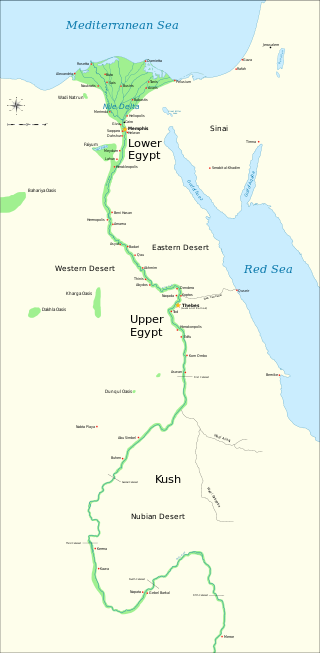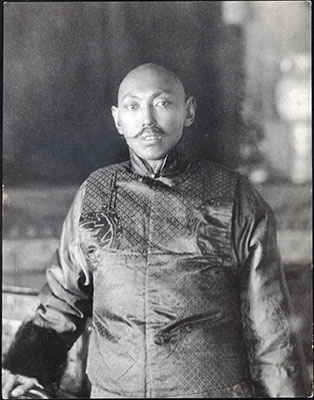
Ancient Egypt was a civilization of ancient Northeast Africa. It was concentrated along the lower reaches of the Nile River, situated within the contemporary territory of modern-day Egypt. Ancient Egyptian civilization followed prehistoric Egypt and coalesced around 3100 BC with the political unification of Upper and Lower Egypt under pharaoh or king Menes. The history of ancient Egypt unfolded as a series of stable kingdoms interspersed by periods of relative instability known as "Intermediate Periods". The various kingdoms fall into one of three categories: the Old Kingdom of the Early Bronze Age, the Middle Kingdom of the Middle Bronze Age, or the New Kingdom of the Late Bronze Age.
"Go Down Moses" is an African American spiritual that describes the Hebrew Exodus, specifically drawing from the Book of Exodus 5:1, in which God commands Moses to demand the release of the Israelites from bondage in Egypt. "And the LORD spoke unto Moses, Go unto Pharaoh, and say unto him, Thus saith the LORD, Let my people go, that they may serve me".

Debt bondage, also known as debt slavery, bonded labour, or peonage, is the pledge of a person's services as security for the repayment for a debt or other obligation. Where the terms of the repayment are not clearly or reasonably stated, or where the debt is excessively large, the person who holds the debt has thus some control over the laborer, whose freedom depends on the undefined or excessive debt repayment. The services required to repay the debt may be undefined, and the services' duration may be undefined, thus allowing the person supposedly owed the debt to demand services indefinitely. Debt bondage can be passed on from generation to generation.

Serfdom was the status of many peasants under feudalism, specifically relating to manorialism, and similar systems. It was a condition of debt bondage and indentured servitude with similarities to and differences from slavery. It developed during late antiquity and the Early Middle Ages in Europe and lasted in some countries until the mid-19th century.

Joseph is an important Hebrew figure in the Bible's Book of Genesis. He was the first of the two sons of Jacob and Rachel. He is the founder of the Tribe of Joseph among the Israelites. His story functions as an explanation for Israel's residence in Egypt. He is the favourite son of the patriarch Jacob, and his envious brothers sell him into slavery in Biblical Egypt, where he eventually ends up incarcerated. After correctly interpreting the dreams of Pharaoh, however, he rises to second-in-command in Egypt and saves Egypt during a famine. Jacob's family travels to Egypt to escape the famine, and it is through him that they are given leave to settle in the Land of Goshen.

Georgism, also called in modern times Geoism, and known historically as the single tax movement, is an economic ideology holding that people should own the value that they produce themselves, while the economic rent derived from land—including from all natural resources, the commons, and urban locations—should belong equally to all members of society. Developed from the writings of American economist and social reformer Henry George, the Georgist paradigm seeks solutions to social and ecological problems based on principles of land rights and public finance that attempt to integrate economic efficiency with social justice.

Corvée is a form of unpaid forced labour that is intermittent in nature, lasting for limited periods of time, typically only a certain number of days' work each year. Statute labour is a corvée imposed by a state for the purposes of public works. As such it represents a form of levy (taxation). Unlike other forms of levy, such as a tithe, a corvée does not require the population to have land, crops or cash.

In tsarist Russia, the term serf meant an unfree peasant who, unlike a slave, historically could be sold only together with the land to which they were "attached". However, this stopped being a requirement by the 19th century, and serfs were practically indistinguishable from slaves. Contemporary legal documents, such as Russkaya Pravda, distinguished several degrees of feudal dependency of peasants. While another form of slavery in Russia, kholopstvo, was ended by Peter I in 1723, serfdom was abolished only by Alexander II's emancipation reform of 1861; nevertheless, in times past, the state allowed peasants to sue for release from serfdom under certain conditions, and also took measures against abuses of landlord power.

Slavery in the ancient world, from the earliest known recorded evidence in Sumer to the pre-medieval Antiquity Mediterranean cultures, comprised a mixture of debt-slavery, slavery as a punishment for crime, and the enslavement of prisoners of war.

Slavery in medieval Europe was widespread. Europe and North Africa were part of an interconnected trade network across the Mediterranean Sea, and this included slave trading. During the medieval period (500–1500), wartime captives were commonly forced into slavery. As European kingdoms transitioned to feudal societies, a different legal category of unfree persons – serfdom – began to replace slavery as the main economic and agricultural engine. Throughout medieval Europe, the perspectives and societal roles of enslaved peoples differed greatly, from some being restricted to agricultural labor to others being positioned as trusted political advisors.
In the late Roman Empire and the Early Middle Ages a colonus was a tenant farmer. Known collectively as the colonate, these farmers operated as sharecroppers, paying landowners with a portion of their crops in exchange for use of their farmlands.

The economy of ancient Greece was defined largely by the region's dependence on imported goods. As a result of the poor quality of Greece's soil, agricultural trade was of particular importance. The impact of limited crop production was somewhat offset by Greece's paramount location, as its position in the Mediterranean gave its provinces control over some of Egypt's most crucial seaports and trade routes. Beginning in the 6th century BC, trade craftsmanship and commerce, principally maritime, became pivotal aspects of Greek economic output.
Nobi were members of the slave class during the Korean dynasties of Goryeo and Joseon. Legally, they held the lowest rank in medieval Korean society. Nobi were considered property or chattel, and could be bought, sold, or gifted.

There were three main feudal social groups in Tibet prior to 1959, namely ordinary laypeople, lay nobility, and monks. The ordinary layperson could be further classified as a peasant farmer (shing-pa) or nomadic pastoralist (trokpa). To influence politics and religion, entering into monkhood and the military was required.

Georgian feudalism, or patronkmoba, as the system of personal dependence or vassalage in ancient and medieval Georgia is referred to, arose from a tribal-dynastic organization of society upon which was imposed, by royal authority, an official hierarchy of regional governors, local officials and subordinates. It is thought to have its roots into the ancient Georgian, or Iberian, society of Hellenistic period.

Voluntary slavery, in theory, is the condition of slavery entered into at a point of voluntary consent. It is distinguished from involuntary slavery where an individual is forced to a period of servitude usually as punishment for a crime.
Serfdom has a long history that dates to ancient times.

Slavery in ancient Egypt existed at least since the Old Kingdom period. Discussions of slavery in Pharaonic Egypt are complicated by terminology used by the Egyptians to refer to different classes of servitude over the course of dynastic history. Interpretation of the textual evidence of classes of slaves in ancient Egypt has been difficult to differentiate by word usage alone. There were three types of enslavement in Ancient Egypt: chattel slavery, bonded labor, and forced labor. Even these seemingly well-differentiated types of slavery are susceptible to individual interpretation. Egypt's labor culture encompassed many people of various social ranks.

The Wilbour Papyrus, named after the New York journalist who acquired it, Charles Edwin Wilbour, is the largest known non-funerary papyrus from Ancient Egypt. It is an administrative document which contains a survey of cultivatable lands in the late Ramesside Period of the New Kingdom of Egypt. The papyrus is 10 meters long and divided into two sections, text A and text B. Text A contains an extensive account of lands both privately and collectively owned. Text B is much shorter and contains an account of exclusively royal lands. The Wilbour Papyrus is a rare case of a well preserved look into the economic administration of Ancient Egypt. Egyptologists have been able to use it to produce a more complete analysis of the function of the Ancient Egyptian state.

Biblical Egypt, or Mizraim, is a theological term used by historians and scholars to differentiate between Ancient Egypt as it is portrayed in Judeo-Christian texts and what is known about the region based on archaeological evidence. Along with Canaan, Egypt is one of the most commonly mentioned locations in the Bible, and its people, the Egyptians, play important roles in the story of the Israelites. Although interaction between Egypt and nearby Semitic-speaking peoples is attested in archaeological sources, they do not otherwise corroborate the biblical account.













